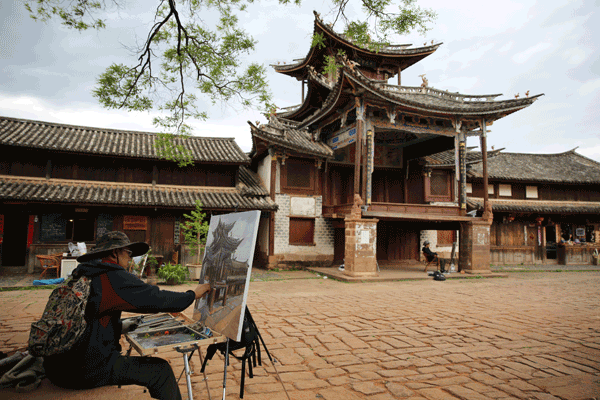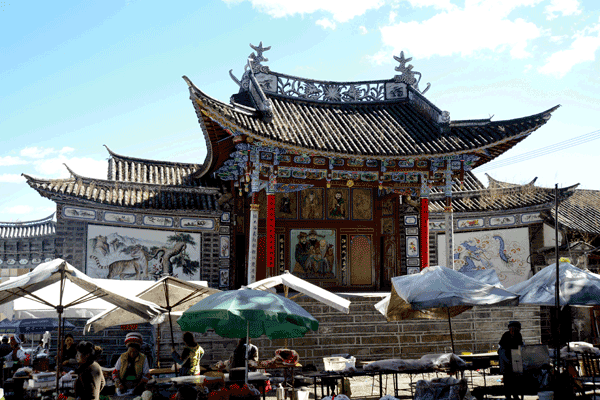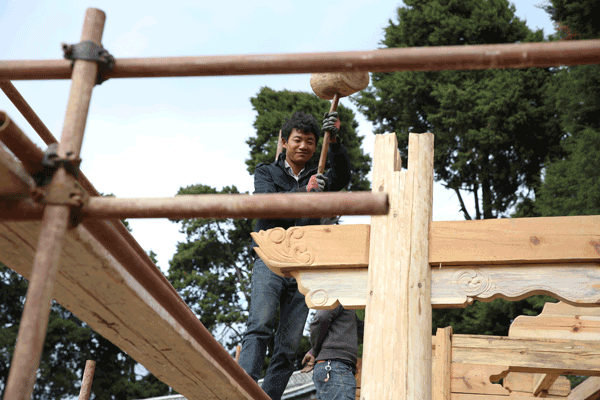 |
A local artist produces a painting of Shaxi, a township in Jianchuan county, Yunnan province.HOU LIQIANG/CHINA DAILY |
Awareness is growing of the need to save age-old settlements that embody traditional lifestyles
Once, all the houses in Zhoucheng village were traditional properties, with three rooms and a screen wall forming a courtyard, an age-old architectural characteristic of residences of the Bai ethnic group.
Now, just four houses in the village, home to 2,500 households in Dali city, Yunnan province, still maintain the traditional values, while the others have either lost their traditional structures and decor as a result of renovation work, or have been demolished to build new houses. The process took just 10 years.
To make matters worse, some newly built houses are just concrete boxes that lack any local cultural characteristics, according to Duan Shusheng, deputy director of the village committee.
Zhoucheng is just one of hundreds or even thousands of traditional Chinese villages that have seen traditional residences fading away, while many face a far worse situation-they are disappearing, as younger, able-bodied residents move away to seek work in big cities, leaving just the elderly behind.
China, the world's second-largest economy, faces challenges in the protection of traditional villages, which are believed to be key repositories of 5,000 years of culture and tradition. In 2012, the central government launched a campaign to protect them, and so far, 4,153 of the most representative villages full of rich cultural relics have been listed and protected as National Traditional Villages.
Although, Zhoucheng was listed as a National Traditional Village in 2012, the destruction of its old residences happened around 2007.
As living standards rose, a growing number of villagers wanted their homes to be upgraded. There were no bathrooms in the old houses, but some villagers wanted them, along with larger kitchens, Duan said.
However, it's more cost-effective to build new houses than renovate the old ones; it costs 30,000 yuan ($4,400) to adapt old houses to include a bathroom, but only 1,000 yuan a square meter to build a new house, he added.
Some families demolished their old houses to build new ones, mainly because there wasn't enough space in the old houses to accommodate the growing number of family members. Many said they would keep their old houses as long as they could obtain land on which to construct new ones. However, the village couldn't offer them the land, according to Duan.
Though dismayed by the situation, Duan is happy to see a growing awareness among residents of the need to protect traditional architecture.
"More villagers now choose to build new houses in the traditional style, and some only use traditional materials," he said.
Zhoucheng is one of 615 traditional villages in Yunnan on the national list.
 |
A stage for traditional opera often hosts performances in Zhoucheng village in Jianchuan county, Yunnan.WANG MINGWEI/CHINA DAILY |
Lack of support
The lack of financial support and low awareness of protection among villagers have exacerbated the problem, said Jin Hongna, an official with the Yunnan Housing and Urban-Rural Development Authority, who is overseeing the protection of traditional villages in the province.
Every traditional village will receive financial support of 3 million yuan a year from the government. However, the money is not intended for the protection and renovation of the villagers' houses, but for infrastructure upgrades, including roads and waste and sewage treatment facilities, Jin said, adding it's difficult for the government to become involved in the protection of privately owned houses.
"With poor ventilation and limited access to sunshine, living conditions in traditional houses built from wood and earth cannot be compared with those in modern, concrete houses. Without financial support, it can be hard to persuade the occupants to preserve their houses just by telling them the old properties are valuable," she said.
So far, the protection of Shaxi, an ancient township in Jianchuan county, Yunnan, has succeeded in the face of new challenges.
Shaxi was once an important hub on an ancient trade road from Yunnan to Tibet. The township fascinated members of the Swiss Federal Institute of Technology in 2000, when they participated in an investigative tour led by local officials. In 2002, the institute, based in Zurich, and the Jianchuan county government jointly launched the Shaxi Rehabilitation Project.
Yang Huiming, head of the township's cultural preservation department, said the Bai ethnic group has a tradition of dividing houses and passing them on to descendants, which helps to maintain the properties because no one is allowed to sell or demolish the houses without the approval of the other residents.
Initially, almost all the villagers were doubtful of the protection project because they thought poor living conditions were normal in these types of houses. "Nobody thought these houses were valuable because they didn't benefit from living in them at all," he said.
Zhang Jizhi, deputy director of the Jianchuan tourism commission, said sweeping changes happened after the local government bought some of the houses and brought in businesses to demonstrate how they could be put to practical use and improve livelihoods.
According to Zhang, many villagers only understood how valuable their houses were after the businesses began to attract tourists, and they have become "proactively" involved in protection efforts: "Some villagers have transformed their houses into guesthouses and transformed themselves into businessmen."
Yang said the ancient township now faces new protection challenges because the number of tourists sometimes exceeds capacity, and some businesspeople damaged the structure or style of some ancient houses when they renovated them.
Experts said the lack of a national protection mechanism and the government's long-term negligence of rural development also produce challenges for the preservation of traditional villages.
From 2001 to 2011, about 80 to 100 villages nationwide disappeared every day, according to Feng Jicai, a renowned writer and a member of the National Committee of the Chinese People's Political Consultative Conference, speaking at a news conference on culture at the fifth session of the 12th CPPCC National Committee in March. The 75-year-old author has spent decades researching the history of ancient traditional villages and campaigning for their protection.
 |
Workmen help to build a local history museum in Shaxi.HOU LIQIANG/CHINA DAILY |
Exodus
While it is encouraging that the central government has listed more than 4,000 settlements as National Traditional Villages since 2012, some are still experiencing an exodus of residents, and some have been damaged by the development of tourism, he said.
At present, there is no formal protection plan for traditional villages, while villagers are mostly unaware of the value of their villages and therefore lack awareness of the need to protect them. In such situations, the villages are prone to damage, he said.
He urged the government to formulate a mechanism for the development of tourism in ancient villages, and said it should not be allowed unless protection is given a high priority.
According to Feng, homes in many traditional villages have been passed down through the generations for hundreds of years, and their protection is related to the inheritance and preservation of the national culture: "They shouldn't be destroyed by the current generation of Chinese people in just a few years."
Zhu Liangwen, a retired professor of architecture at Kunming University of Science and Technology in Yunnan province, said a lack of knowledge has led to the current situation: "For a long time, China's construction authorities paid most attention to urban development. They have limited knowledge of the rural areas, but they haven't conducted sufficient research into rural development. Instead, they sit in offices talking about the issue."
The 79-year-old academic, who has devoted himself to the protection of traditional residential architecture since 1981, said that lacking proper understanding of rural areas, many planning institutes in cities drew up plans for traditional villages based on their experience of urban development.
Most of the planning they conduct is impractical and the planners usually leave after drawing up their plans, but few rural residents have the ability to carry out the work, and there are few government documents to explain how to manage rural construction companies or the extent of the developers' power.
It can be hard for architectural experts to protect traditional houses because they may have to heed village heads with little or no knowledge of architecture, he said.
Zhu has found it difficult to get full cooperation from village heads to carry out his plans and said he argues with them regularly.
In Azheke village, Yuanyang county, Yunnan, the village head demolished a small house used for sacrifices to gods and ancestors-the only one in the immediate vicinity-without listening to Zhu's suggestions about preserving it.
"Many villagers and officials are at least 15 years behind the scholars who serve as heralds in the protection of traditional architecture. Only in about 15 years will they realize what a great pity it was that they demolished these ancient houses," he said.